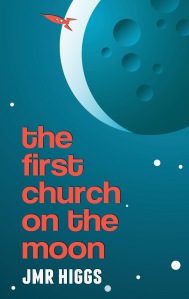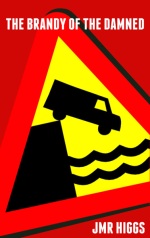Jason Arnopp interviews JMR Higgs
August 10, 2013 at 9:37 am johnhiggs 1 comment
To celebrate publication of The First Church on the Moon, JMR Higgs’ sort-of sequel to The Brandy of the Damned, the author has been interviewed by none other than Jason Arnopp. Jason is the screenwriter of horror movies including Stormhouse and the writer of many Doctor Who, Sarah Jane Adventures and Friday 13th audios and books. None of that impresses us at all. No, the reason we at The Big Hand idolise Arnopp is because he is also the author of The Darkness: Permission to Rock. Yeah! I know!
Here’s the interview:
JA: How would you quickly sum up The First Church on the Moon?
JMRH: The First Church on the Moon is a comedy about the staff of the Steve Moore Moonbase waking up with hangovers, and trying to work out exactly what happened the previous night. Alcohol on the moon is not a good idea, as I’m sure you know. Nor are cats. Or Free Will. It’s basically a novel about things that are not a good idea on the moon, most notably alcohol, cats and free will.
It’s also a concerted effort to imagine a positive future. Most of our current visions of the future are visions of collapse, and I wanted to imagine a future that didn’t shy away from the looming climate and energy problems but which still painted a future that was thriving and where people had a good time.
JA: The First Church on the Moon is much more of a comedy than The Brandy of the Damned. Why the change of tone?
JMRH: Partly for the challenge. Writing a novel that works is hard but writing a novel that works and is also funny is harder still.
Actually, that’s not true. I assumed that would be the case when I started but writing comedy was much easier. It was so much fun to do that I loved every minute of it and it never became a chore. I suspect all those comedy writers who say writing comedy is difficult are basically trying to convince their spouses that they’re deserving of sympathy and respect, even though they’ve just been mucking around all day giggling to themselves.
The other reason is that it is the middle part of a trilogy of three short-ish novels about transformative journeys. The first was The Brandy of the Damned and that was aimed at the head without being rational. This one is aimed at the heart without being sentimental, and the third one will be much more on the sex and death level whilst in no way being gothic or erotic. These are the constraints I set myself at the outset to avoid writing anything predictable or unoriginal. And the way I avoided being sentimental in this one was to be silly. Silliness is a great disinfectant to remove all but the deepest emotions, I think.
Plus it’s an effort to make the wild metaphysical speculations that so plague my books more acceptable, so for all those reasons it was always going to be a comedy.
JA: That third part of the trilogy – is that Phwoar & Peace?
JMRH: It is. Or at least, I hope that is what it will be end up being called, but there’s every chance I may come to my senses and call it something else. But Phwoar & Peace is a step up from some of the titles it has had previously. It was called Michael Once Fucked A Mermaid for a while. That’s really not a good title.
JA: Any idea when that will be released?
JMRH: Not for a while, certainly. I’ll be working on a book about the 20th Century for the rest of the year. I had planned to work on Phwoar & Peace after that, but a couple of other book ideas are shouting at me and for various reasons they need to be done sooner rather than later. So I may put it off for a bit. Plus I’m scared of it. I think it may be genuinely impossible to pull off, or at least it looks that way at the moment. After I had written The KLF and The Brandy of the Damned I seriously thought about not releasing them, as you know, because I thought they might get me sectioned. But this is the only book I’ve been afraid of releasing before it has even been written.
JA: The First Church on the Moon was credited to ‘JMR Higgs’, while the KLF book is coming out as ‘John Higgs’. Is there any logic there?
JMRH: Yeah, almost. ‘JMR Higgs’ is the indie novelist side of me, whereas ‘John Higgs’ is the traditionally published non-fiction author. The KLF and 20th Century will both come out properly on Orion as ‘John Higgs’, like the Timothy Leary biography. Those books are the result of an awful lot of thought, research and work and a great deal of concern for the reader and the bookseller and the publisher has gone into them. They should make sense to the wide world, basically. JMR Higgs books, on the other end, are the product of a dialogue between me and my subconscious and they are under no pressure to please anyone other than me, myself and I. So when they do find themselves chiming with others, that’s a real delight.
I can’t recommend having a foot in both camps enough, its keeps your non-fiction original and your fiction believable. It’s a bit like a band going between tour and studio, tour and studio. Also the subjects of the non-fiction act as a flag to attract people who might be on your wavelength and persuade them that maybe it’s worth risking the fiction.
JA: Will future JMR Higgs books keep the comedy up front?
JMRH: It could go either way at the moment. A lot will depend on the reaction to First Church, I think. Cruel experience tells me that my sense of humour is a bit suspect and something of an outlier, so it depends on whether it reaches enough people with a similarly wrong-headed view of things.
JA: One reference I didn’t understand was the naming of the Moonbase – the Steve Moore Moonbase. Is there a story there?
JMRH: The short answer is that I was reading Somnium by Steve Moore, which is a book about someone in love with the moon that was clearly written by an author who is in love with the moon, so it pleased me to think that there might be a Steve Moore Moonbase one day. The longer answer is that Steve Moore is probably best known for his influence on the considerably more famous Alan Moore, to the extent that he jokes his gravestone will read “Steve Moore – no relation.” But it struck me that the concept of Alan Moore is quite a complex and knotty one. There’s his comic work, his magic work, his influence on culture such as the V for Vendetta mask, his anti-Hollywood stance, his pro-Northampton stance – there’s a lot for future generations to get their heads around. Whereas, the notion that Steve Moore is the bloke who is in love with the moon is immediate and succinct, and as generations pass and memories become stories then stories become legends, I could see that notion being absorbed very easily into the collective unconsciousness. I could imagine that a few centuries from now academics would know all about Alan Moore, but everyone would know Steve Moore because there would be nursery rhymes told about him.
—
The First Church On The Moon is available now ( UK Paperback | UK ebook | US Paperback | US ebook )
The Brandy of the Damned by JMR Higgs and The Beast In The Basement by Jason Arnopp are available together as a AA-sided low-cost ebook.
Jason Arnopp is also author of How To Interview Doctor Who, Ozzy Osbourne And Everybody Else.
Entry filed under: John Higgs, Uncategorized. Tags: First Church on the Moon, Jason Arnopp, JMR Higgs.









1. Weekend Links: Ebooks, editors + “eyeball-hours” | July 6, 2014 at 11:10 pm
[…] “Jason Arnopp interviews JMR Higgs” (Jason Arnopp & John […]